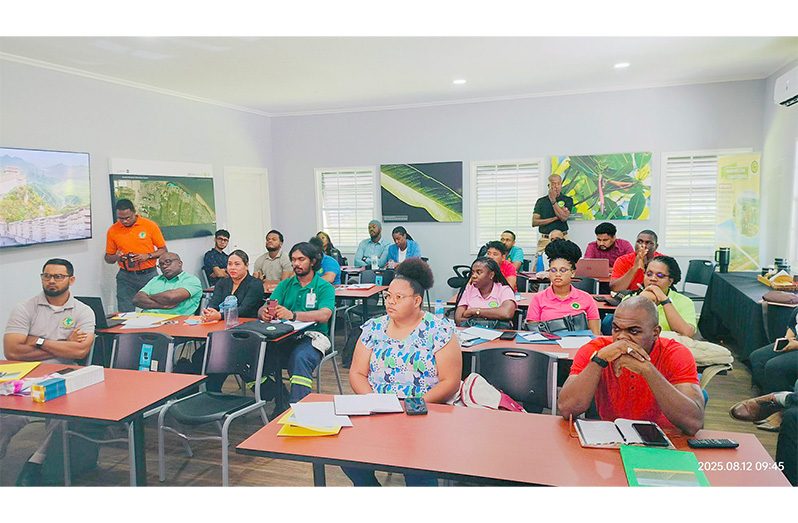– Guyana’s bold step in crop diversification
ON the Soesdyke-Linden Highway, farmer Muhammad Haron left a recent training session with renewed optimism. With a notebook in hand and visions of trellises heavy with dragon fruit, he expressed his excitement: “I enjoyed the way the information was presented. The interaction with the experts was great, and I am looking forward to planting dragon fruit on our farm. I believe it will be successful.”
Haron is among dozens of farmers now at the forefront of a ground-breaking agricultural initiative in Guyana. The Guyana Lands and Surveys Commission (GLSC), in partnership with the Food and Agriculture Organization of the United Nations (FAO) and the National Agricultural Research and Extension Institute (NAREI), has launched a pilot programme to introduce commercial dragon fruit cultivation in Regions Four and Ten.
This is no ordinary crop experiment. Funded by the Guyana REDD+ Investment Fund (GRIF) through the Mainstreaming Sustainable Land Development and Management (SLDM) project, the initiative seeks to reclaim mined-out lands, strengthen food systems, and open new markets for Guyanese farmers.
LESSONS FROM BRAZIL
The idea was born during a learning journey last year to Brazil’s Agricultural Research Corporation (EMBRAPA).
There, Guyanese experts studied how countries are turning degraded lands into fertile ground again through agroforestry, soil conservation, and reclamation projects. Among the crops highlighted was dragon fruit—a vibrant, nutrient-rich fruit that thrives even in poor soils.
Inspired by Brazil’s success, the team saw an opportunity to reimagine parts of Guyana’s agricultural landscape. “This high-value crop is new to Guyana,” explained Kevin Paul of NAREI. “With both wet and dry conditions suitable for its cultivation, and with the training, farmers can easily produce dragon fruit. It will increase income and move Guyana from importing to producing — and even exporting.”
BUILDING FARMERS’ CAPACITY
The programme began in August with two intensive training sessions. The first, a Training of Trainers (ToT) at NAREI’s Mangrove Hall in Mon Repos, brought together 32 representatives from NAREI, the University of Guyana’s Faculty of Agriculture and Forestry, the Guyana School of Agriculture, and GLSC. A follow-up session at NAREI’s Kairuni Station on August 14 provided 37 farmers from the Soesdyke-Linden corridor with hands-on experience in dragon fruit farming.
Under the guidance of FAO experts Nguyen Van Son and Md Fazlay Arafat, participants learned everything from soil preparation and trellising systems to pest management and post-harvest care. They also worked directly in NAREI’s dragon fruit orchard, gaining the confidence to replicate what they saw on their own farms.
Beyond education, the project provides farmers with the tools to succeed. Each beneficiary will receive 200 dragon fruit saplings and 50 prefabricated trellises, along with ongoing technical support from NAREI’s extension team. Training manuals, post-harvest guidance, and access to market linkages are also part of the package.
For farmers, this means moving quickly from theory to practice. For Guyana, it means advancing a broader vision of agricultural diversification and resilience.
SLDM Project Manager, Ahmed Jan, underscored the significance: “Crop diversification is key to stronger food systems and better farmer incomes.” His sentiments were echoed by David Fredericks, NAREI’s Chief Scientist, and Asib Mohammed, GLSC’s Project Officer, who both stressed collaboration as the key to making dragon fruit a viable cash crop in Guyana.
A CROP WITH PROMISE
Dragon fruit, also known as pitaya, is no stranger to global markets. Its rising popularity as a “superfruit” makes it a premium commodity, commanding high prices and consistent demand. By cultivating it locally, Guyana can reduce imports in the short term and eventually tap into export opportunities.
Just as importantly, the crop is drought-tolerant, making it a strong candidate for climate resilience strategies. Beyond orchards, the initiative is expected to stimulate new value chains—such as nurseries, trellis fabrication, aggregation, and agro-processing—offering additional income opportunities for rural communities.
For now, the pilot in Regions Four and Ten represents the first step in what could become a national movement. Mined-out lands once written off as barren may soon yield orchards of dragon fruit, symbolising not just agricultural innovation but also sustainable land management.
For farmers like Muhammad Haron, the promise is simple but powerful: new skills, new crops, and new hope. And for Guyana, it is a chance to prove that innovation in agriculture can turn challenges into opportunities, one dragon fruit at a time.
From mined-out lands to Dragon Fruit orchards
SHARE THIS ARTICLE :
Facebook
Twitter
WhatsApp





.jpg)








